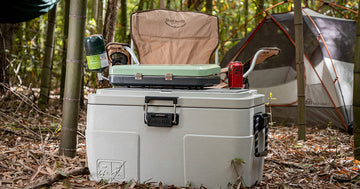When it comes to camping, one of the essentials that can make or break your outdoor experience is the type of cooler you bring along. Whether you're at your favorite campsite for a weekend or you're headed out into the backwoods for a week-long adventure, you need a cooler that keeps your food fresh, your drinks chilled, and your ice from melting too quickly.
These days, the options for camp coolers are better than ever, combining durability, extreme ice retention, and innovative features that cater to every kind of camper. Here are some options for great camping coolers to bring along on your next outdoor adventure.
How to Choose the Best Cooler for Camping

How do you choose the best cooler for camping? Consider what you'll be using it for, the length of your trip, and any extra features you might need.
- Duration of Your Trip: Longer trips require larger coolers with better ice retention to keep your food cold and safe.
- Type of Camping: Are you car camping, backpacking, or setting up a base camp for other activities? This will influence the size and type of cooler you need.
- Capacity Needs: Estimate how much food and how many beverages you plan to bring. Cooler space is key, especially for larger groups.
- Portability: If you need to move the cooler often, a wheeled cooler might be ideal. For rugged terrain, a more durable cooler with handles might be necessary.
-
Extra Features: Consider coolers with built-in cup holders, dividers, or a lid that doubles as a cutting board.
Best Types of Camping Coolers

1. Hard-Sided Cooler
Hard-sided coolers are some of the best coolers for camping due to their rugged construction and excellent ice retention. They're typically made from ultra-durable materials (think stuff so strong it's bear resistant), which keeps your beverages cold and ice frozen for days. They're ideal for car camping or base camps where moving the cooler isn't required frequently.
- Best for: Extended camping trips, large groups, and situations where durability is key.
- Favorite Feature: Ultra-durable construction and top-notch ice retention that can keep contents ice cold for days on end.
-
Durability: Constructed with heavy-duty materials, often featuring closed cell foam insulation and advanced coating technology that resists impacts, UV damage, and extreme weather conditions.
2. Soft-Sided Cooler
If you're looking for a more affordable cooler, a soft cooler is a great choice that can be used for day trips or overnight camping. They are lighter than hard-sided models and easier to carry, but they still offer great ice retention thanks to high-quality insulation materials. Plus, a soft cooler often comes with features like shoulder straps or handles for easy transport.
- Best for: Day trips, small families, or individual use where portability is important.
- Favorite Feature: Lightweight design that also features surprisingly good ice retention; often comes with extra pockets for storage.
-
Durability: Made with high-density fabric that's tear and puncture-resistant, suitable for rough terrain and regular use.
3. Backpack Cooler
For hikers and backpackers, a backpack cooler may be easier to transport. These coolers are designed to be as lightweight as possible while still keeping your drinks cold and food fresh. A backpack cooler is comfortable to carry, with straps designed to distribute weight evenly, making them perfect for long hikes.
- Best for: Hikers and backpackers who need to keep supplies cold without adding much weight.
- Favorite Feature: Ergonomic design that distributes weight evenly across the back, making it comfortable to carry over long distances.
-
Durability: Utilizes rugged, water-resistant materials designed to handle the wear and tear of long hikes and outdoor exposure.
4. Floating Cooler
A floating cooler is perfect for anyone planning to spend time camping near water bodies. These coolers are designed to float alongside you while you're in the water, keeping your beverages within easy reach without having to go back to shore.
- Best for: Water-based activities like kayaking, boating, or floating down a river.
- Favorite Feature: Its ability to float securely next to you, keeping your cold beverages within arm's reach while you're in the water.
-
Durability: Built with waterproof and UV-resistant materials that withstand sun exposure and stay buoyant in water.
5. High-Capacity Cooler
For larger groups or extended trips, a high-capacity cooler is a must. These coolers offer plenty of cooler space to store several days' worth of food and beverages. A high-capacity cooler will still keep your perishables cold, even in hot weather.
- Best for: Large families or groups camping for several days who need to store plenty of food and beverages.
- Favorite Feature: Massive storage capacity with compartments that help you separate and organize different types of food and drinks.
-
Durability: Features sturdy, reinforced construction capable of handling heavy loads and frequent use during extended camping trips.
6. Lightweight Cooler
A lightweight cooler is ideal for solo campers or small groups who need mobility. These coolers are designed to offer a balance between being light enough to carry easily while still providing enough insulation to keep contents cold for many days.
- Best for: Quick trips or for those who prefer easy mobility with their gear.
- Favorite Feature: Its ultra-light build, which does not compromise on cooling efficiency for short-term use.
-
Durability: Although designed for lightness, a lightweight cooler uses durable materials that don't compromise on resilience, ensuring they handle the rough and tumble of the outdoors.
7. Multi-Compartment Cooler
A multi-compartment cooler helps keep your food organized and accessible. With separate compartments for drinks, perishables, and ice, these camping coolers are perfect for keeping raw food away from other items and organizing your supplies efficiently.
- Best for: Campers who prioritize organization and want to keep food items separate to prevent cross-contamination.
- Favorite Feature: Multiple compartments that help in separating beverages from perishable items and raw foods from cooked ones.
-
Durability: Built with partitioned sections that keep your items separated.
8. Insulated Cooler Bag
For minimalists or those who prefer to pack light, insulated cooler bags are an excellent choice. While they might not offer the long-term ice retention of larger, more robust coolers, they are perfect for keeping items cool for short periods and can be easily folded away when not in use.
- Best for: Minimalist campers or those who want to bring along a smaller option for a day hike.
- Favorite Feature: Flexibility and ease of storage when not in use, plus the ability to fold away compactly.
-
Durability: Constructed from durable insulated materials that prevent tears and leaks, extending the life of the bag despite frequent use and filling.
9. Thermoelectric Cooler
A thermoelectric cooler (powered cooler) offers a unique advantage for campers: it uses electricity to keep items cold without any ice. This type of cooler is a great choice for campers with access to a power source and who prefer the convenience of not dealing with ice.
- Best for: Campers who have access to a power source and prefer a cooler that can cool contents without ice.
- Favorite Feature: Its ability to plug into a vehicle’s 12V outlet or a standard wall outlet, making it versatile for road trips or campsite use where electricity is available.
-
Durability: Less rugged than traditional hard-sided coolers due to their electrical components, but designed to withstand normal travel use.
Must-Have Cooler Accessories for Camping

- Ice Packs: Ice packs are a must-have for any cooler. They help maintain a low temperature longer than regular ice, without creating messy water from melted ice. Look for ice packs that fit the shape and size of your cooler for maximum efficiency.
- Dry Goods Baskets: These handy inserts help keep snacks and smaller food items organized and accessible, preventing them from getting crushed or lost under larger items. Snack racks are perfect for keeping your dry snacks or sandwiches from getting soggy.
- Dividers: Dividers allow you to split your cooler into dedicated zones, one for drinks and one for food items, for example. This helps you organize the space more efficiently and can also keep ice from melting too quickly.
- Cooler Cushions: Add a dual-purpose cushion or tracpad to your hard-sided cooler to turn it into a comfortable seat. This is especially valuable when space is at a premium, and you want to minimize the camping chairs you need to bring along.
-
Tie-Down Kits: If you’re traveling in rough terrain or weather, a tie-down kit can secure your cooler to your vehicle, boat, or table, preventing it from sliding around and getting damaged.
The Perfect Camping Cooler for Your Outdoor Adventures

As you're looking for the best camping coolers, consider what type of camping you'll be doing, how long you'll be out, how much you need to carry, and what extra features might enhance your experience. Whether you need a soft cooler for quick getaways or a high-end camping cooler for long expeditions, there's a Rugged Road cooler that will meet your needs.
Remember, the camping cooler you choose should be a valuable piece of your camping equipment. It will enhance your outdoor experience, provide convenience, and will keep your food and beverages cold for the entire duration of your trip. Get ready to create unforgettable memories with a cooler that’s as ready for adventure as you are.


